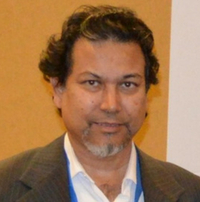Day 1 :
Keynote Forum
Jing Wang
Full Professor, University of South Florida, USA Director of RF MEMS Transducers Group
Keynote: RF/Bio MEMS Transducers for Microsystems-on-a-Chip
Time : 10:00-10:45

Biography:
Jing Wang is a Full Professor in Department of Electrical Engineering at the University of South Florida, which he joined since 2006. He got dual B.S. degrees in Electrical Engineering and Mechanical Engineering from Tsinghua University in 1999. He received two M.S. degrees, one in electrical engineering, the other in mechanical engineering, and a Ph.D. degree from University of Michigan in 2000, 2002, 2006, respectively. His research interests include micromachined transducers, RF/Bio-MEMS, lab-on-a-chip and microfluidics, functional nanomaterials, nanomanufacturing, and RF/microwave devices. His work has been funded for more than $10M by research grants from federal agencies (NSF, DTRA, US Army, US Air Force, etc.) and contracts from more than a dozen companies. He has published more than 120 peer-reviewed papers and held 10 US patents. He serves as the chairperson for IEEE MTT/AP/EDS Florida West Coast Section and Director for the Wireless and Microwave Information (WAMI) Center. He has been elected as a member of the prestigious IEEE MTT-Technical Coordinating Committee on RF MEMS. He has chaired IEEE Wireless and Microwave Technology Conference (WAMICON) in the last a few years.
Abstract:
This talk is going to present our recent efforts towards strategic design, advanced manufacturing, and characterization of miniaturized devices for emerging RF/MW/Biomedical microsystems.
Firstly, this talk will discuss design, fabrication and testing of high-frequency selectivity (high-Q) on-chip micro-resonators for wireless telemetry and sensor applications. The most recent progress in the area of high-Q micromechanical resonators will be presented, which outperform the current state-of-the-art QCM, SAW and BAW devices, thus enabling the next generation point-of-care and/or disposable biosensor applications. This talk will also review our ongoing efforts for implementation of chip-scale acoustic/optical sensing platforms by taking advantages of optical and acoustic resonances. The ability to integrate an array of miniaturized capacitive/piezoelectric micromachined ultrasonic transducers offers unique performance benefits thus enabling continuous monitoring or imaging.
Secondly, this talk will discuss the fabrication and characterization of surface-attached microbeam arrays of that are made of a thermoresponsive polymer with embedded spherical or octopod Fe3O4 nanoparticles. Turning on and off an AC-magnetic field induces the microbeam array to expel or imbibe water due to the hydrophilic-to-hydrophobic transition, leading to a reversible transition from a buckled to non-buckled state. It is shown that the octopod nanoparticles have a heating rate 30% greater (specific absorption rate) than that of the spherical nanoparticles, which shortens the response time of the polymer MEMS micro-actuators. It is further demonstrated that this shape transition can be used to propel 50μm spherical objects along a surface. It holds promise of harnessing shape-shifting patterns in microfluidics for manipulation biological samples, which is crucial for microbiology, pharmaceutical science, and related bioengineering fields.
Networking & Refreshment Break: 10:45-11:00
Keynote Forum
Anis Rahman* and Aunik Rahman
President/CTO, Applied Research & Photonics, Inc., USA
Keynote: Screening a cancerous cell with terahertz multispectral imaging
Time : 11:00-11:45

Biography:
Dr. Anis Rahman is an acclaimed scientist for metrology. He is a winner of many scientific awards including NASA Nanotech Brief’s “Nano-50” award twice; CLEO/Laser Focus World’s “Innovation award;” and “2015 MP Corrosion Innovation of the Year,” by the NACE. HE is the Founder of Applied Research & Photonics (ARP), a leading terahertz metrology company located in Harrisburg, PA (see http://arphotonics.net). His invention of “Dendrimer Dipole Excitation,” a new mechanism for terahertz generation, makes it possible to generate high power terahertz radiation. With sub-nanometer resolution, terahertz metrology offers tremendous savings in time and cost for semiconductor process development.
Abstract:
Recently terahertz multispectral reconstructive imaging has attracted tremendous attention for soft tissue imaging because of the non-ionizing nature of the T-ray that does not impart any radiation damage like X-ray. Here, examples of human skin tissue imaging are presented. Reconstructive imaging utilizes the technique of rasterizing a specimen over a given volume. The resulting three-dimensional matrix, termed as the Beer-Lambert reflection (BLR) matrix, is utilized to compute a 3D lattice for the image generation. ARP’s instrument allows the T-ray beam to be focused on a given layer under the surface; therefore, a 3D volume may be rasterized on a layer by layer basis. The algorithm used for image generation is capable of accurate representation of the measured object similar to a charged couple device as has been explained elsewhere. Here we present images of human skin under different diseased conditions as compared to healthy skin samples. Fig. 1 exhibits terahertz reconstructive 3D image of a skin sample where regular cellular pattern is visible. However, some cell has started deforming because of the onset of disease attack. As outlined, a combination of presence or absence of regular cellular structure, terahertz spectral comparison, and lack or presence or layering information is expected to serve as a fool proof diagnostic tool for different kind of skin cancers.
Group Photo : 11:45-12:00
- Sessions: Biosensors for Imaging | Environmental Biosensors | Bioinstrumentation | Advancement in Nanotechnology | BioMEMS/NEMS | Gas Sensors | Bioengineering Applications
Location: Franklin

Chair
Tom Zimmermann
Michigan State University, USA
Session Introduction
Ridwan F. Hossain*, Anupama B. Kaul
University of North Texas, USA
Title: Inkjet printed 2D biocompatible photodetector for biosensing applications

Biography:
Ridwan Fayaz Hossain is a Ph.D. candidate in Electrical Engineering department at University of North Texas. His Ph.D. research is focused on ink-jet printing of 2D layered materials for flexible and printed electronics, with a particular emphasis on bio-related applications and bioelectronics. He has published more than 15 papers in reputed journals (Nature 2D materials and Application, 2D Materials, Journal of Materials Chemistry C, Biomedical Microdevices etc.).
Abstract:
Age-related macular degeneration (AMD), a retinal degenerative disease that results in a continuous degeneration of photoreceptors in the retina which eventually leads to complete blindness. One approach to combat AMD is through the use of artificially implantable photodetectors that are physically placed on the retina. The large format photodetector pixels on the flexible and conformable substrate allows the implantable photodetectors to be in intimate contact to retinal pigment epithelium. Interestingly, 2D materials such as photosensitive and semiconducting molybdenum disulfide (MoS2) and electrically conducting graphene have recently received tremendous promise due to their unique photonic and optoelectronic properties properties and their potential in various types of micro and nano devices. In this study, we have tested the biocompatibility of various 2D materials, such as graphene and MoS2 in several organic solvents. Specifically, these materials have been dispersed in Isopropyl Alcohol (IPA), a mixture of Cyclohexanone/Terpineol 7:3 ratio (C/T), and N-Methyl-2-pyrrolidone (NMP). Mouse Embryonic Fibroblast (STO) was used for the biocompatibility analysis for inks drop cast on flexible polyimide substrate. The inks formed using 2D graphene and MoS2, were highly biocompatible on polyimide substrates, where a cell survival rate of up to 98% was measured for the STO, while the cell confluence rate was in between 70-98%. Here, a new approach was utilized to form photosensitive pixels that utilize heterostructures of inkjet printed MoS2 and graphene, using inks that also show a high degree of biocompatibility. The inkjet printed 2D heterostructure devices were photoresponsive to broadband incoming radiation in the visible regime, and the photocurrent scaled proportionally with the incident light intensity, exhibiting a photoresponsivity R ~ 0.30 A/W. This is 103 times higher compared to prior reports, and detectivity D was calculated to be ~ 3.6 × 1010 Jones at room temperature. Strain-dependent measurements of photocurrent with bending was also conducted, that showed a photocurrent of ~ 1.16 µA with strain levels for curvature up to ~ 0.262 cm-1, indicating the feasibility of such devices for large format arrays printed on flexible substrate, unlike conventional Si implantable detectors that are rigid and nonconformable. In conclusion, the inkjet printed, biocompatible 2D hetero-junction photodetector formed on flexible and conformable substrates was successfully shown to be photoresponsive to a wide range of light intensities and strain levels, making it a promising prospect for in vivo bio-sensing applications for AMD.
Workshop
Session Introduction
Bill Jackson
Founder and Chief Scientist, Base Pair Biotechnologies, USA
Title: Aptamers for quantitative sensing of small molecules using graphene biosensors and surface enhanced raman spectroscopy
Time : 12:00-13:00

Biography:
Bill Jackson is the Founder and Chief Scientist of Base Pair Biotechnologies. He is an experienced biomedical and chemical engineer in charge of molecular diagnostic and molecular biology development at Base Pair. He is a recognized leader in the aptamer space having authored 12 peer-reviewed publications on aptamers as well as 30+ posters and conference proceedings. He is also an inventor of Base Pair’s patented, multiplex aptamer selection process and inventor on 12 other issued patents and a number of additional patents pending. He holds a B.S. in biomedical engineering from Texas A&M University and a Ph.D. in chemical engineering from the University of Houston.
Abstract:
In many cases, conventional affinity reagents (e.g. antibodies) are not well suited for the sensitive detection of small molecule analytes. Small molecule targets are often non-immunogenic or, at the other end of the spectrum, too toxic for effective production of antibodies. Furthermore, many classes of pharmaceuticals such as opioids, for example, comprise many molecules of very similar structure, and therefore the available antibodies are cross-reactive. Aptamers, however, are discovered by purely in vitro means and thus toxicity or lack of immunogenicity are not an issue in their discovery. Furthermore, negative selection steps can be performed to rid candidate pools of binders to closely related analyte confounders.
In the presentation, we highlight the use of novel aptamers to small molecules discovered at Base Pair in two separate sensing platforms – 1) a commercial graphene-based field effect biosensor, and 2) surface enhanced Raman spectroscopy. Among the analytes are tenofovir, an important HIV drug, several opioid compounds, and a metabolite implicated in early, asymptomatic malaria infection. We present limits-of-detection in each platform as well as the potential advantages and disadvantages of each.
Lunch Break: 13:00-13:45
Exhibitor Presentation
Session Introduction
G Thomas Caltagirone
CEO & President, Aptagen LLC, USA
Title: What are Aptamers?
Time : 13:45-14:20

Biography:
G Thomas Caltagirone is the President & CEO of Aptagen and has over 25 years of research and business experience in start-ups. A native of York, PA, he began his studies at the University of the Sciences in Philadelphia followed by a PhD in neuroscience from Drexel University. He completed his thesis on “Proton-Sensitive Ribozyme Switches with Molecular Memory” at Yale University, and has several patents and publications under his name.
Abstract:
Aptamers (synthetic antibodies) are stable DNA or RNA ligands that bind with high affinity and specificity to target antigens such as small molecules, peptides, proteins, cells, and tissues. For example, aptamers have been generated that exhibit greater than 10,000-fold binding affinity for theophylline over caffeine, which differ only by a few atoms. Aptamer products can be used as research reagents, diagnostics, biosensors, and tools for biomarker or drug discovery. Aptamers can also be used for bioindustrial applications and targeted therapeutics.
- Sessions: Biosensors | Biosensors Applications | Transducers in Biosensors | DNA Chips and Nucleic Acid Sensors | Bioelectronics | Photonic Sensor Technologies | Biosensing TechnologiesBiosensors
Location: Franklin

Chair
Jing Wang
University of South Florida, USA

Co-Chair
Tom Zimmermann
Michigan State University, USA
Session Introduction
Tom Zimmermann
Professor, Michigan State University, USA
Title: Automation of biotechnological bioreactor production processes
Time : 14:20-14:55

Biography:
The change of health care towards personalized medicine requires an adaptation of the biomedical and pharmaceutical production. The demand for sophisticated and customized products, including monoclonal antibodies, therapeutic proteins and vaccines, is ever growing. At the same time, high efficiency and product quality are key requirements. A personalized and affordable medicine requires low volume and highly parallelized production methods, frequently realized in single-use bioreactors. Complexity and requirements of strictly controlled bioreactor processes are increasing rapidly. A continuous measurement of relevant process parameters and full automation of biotechnological production processes are critical to a high process yield and productivity. Parallel real-time in-situ monitoring of a variety of parameters in complex fluids can be realized by suitable multi-sensor systems (Fig. 1). Integrated disposable in-situ monitoring and control systems are not commercially available, yet. Required systems should control typical parameters of a cell culture in a bioreactor process and monitor various metabolic proteins and lactate, the nutrient glucose and cell density as well as the pH and the temperature. Integrated bioMEMS with a functionalized bioactive recognition layer shall be used to detect in-situ and in real-time most specifically on the biomolecular level bioanalytes of interest in highly complex bioreactor environments. Key for a stable, reliable, and robust in-situ sensor- and actor-system with low bio-fouling property might be the use of highly biocompatible diamond and carbon material systems.
Abstract:
Tom Zimmermann was head of the business unit Biohybrid Systems at Fraunhofer and is with the Michigan State University since 2017. His research activities are in the field of diamond bioMEMS solutions in biomedical diagnostics, automation of biotechnological processes, and food analysis as well as in the development of diamond high-power terahertz systems. He graduated in solid-state electronics at the University Ulm (Germany), in 2002. Having received a PhD degree in electrical engineering from the University Ulm (diamond and III-V devices), he joined the University of Notre Dame, in 2006. Here, he pursued research in high-power high-frequency devices, first as a post-doc and later on as research assistant professor. His research record: 30+ peer-reviewed papers, 60+ conferences.
Yasushi Takemura
Professor, Yokohama National University, Japan
Title: Wireless power transmission to medically implantable device using magnetic wire
Time : 14:55-15:30

Biography:
Yasushi Takemura is Professor of the Electrical and Computer Engineering, Yokohama National University, Japan, where he has been since 1993. He received the B.S., M.S., and Ph.D. degrees in Electrical and Electronic Engineering from Tokyo Institute of Technology, Tokyo, Japan, in 1988, 1990, and 1993, respectively. His research interests are magnetics, magnetic sensor, magnetic materials, and bio-medical application of magnetic nanoparticles. He has published more than 150 papers in reputed journals.
Abstract:
Wireless power transmission to a medically implantable device deeply located in the human body is essential to develop future therapeutic and diagnosis technology. We present a power receiving module of 20 mW using a thin magnetic wire of 0. 25 mm diameter.
A magnetization reversal in magnetic wires with bistable magnetization states induces pulse voltage in a pick-up coil which has been known as Wiegand effect [1]. A twisted FeCoV wire is one of the optimum material yielding this effect. A Fe0.4Co0.5V0.1 wire of 11 nm length was used as the core material in the pick-up coil. An alternating magnetic applied field of 4.8 kA/m at 10 kHz was applied to the wire. The induced votage to the pick-up coil was measured, and the power obtained from this voltage as power source was evaluated [2, 3].
We achieve the wireless power transmission of 20 mW to a medically implantable device under the excitation field condition which can be realized by a body-sized excitation coil with practical power supply. The experimental details and other possible applications [4, 5] including battery-less modules are also discussed in the presentation.
Bryan J. Black
University of Texas, Dallas, USA
Title: Sensory neurons cultured on microelectrode arrays as label-free, non-invasive biosensors for novel analgesic discovery
Time : 15:45-16:20

Biography:
Bryan J Black currently serves as a Research Scientist in the Department of Bioengineering at the University of Texas at Dallas, USA and as an Advisor at Qualia Labs, Inc. In 2014, he was graduated from the University of Texas in Arlington with a Ph.D. in Physics and Applied Physics. His research interests include the development and application of novel in vitro and in vivo neural interfaces to address fundamental questions of neural network connectivity and plasticity as well inflammatory response.
Abstract:
The tolerance, abuse, and potential exacerbation of symptoms associated with classical chronic pain medications (e.g., opioids) creates an urgent need for alternative therapeutics. Phenotypic screening may provide an alternative or complementary approach to traditional molecular target-based drug discovery. Profiling of cellular phenotypes enables quantification of physiologically relevant traits central to a disease pathology without prior identification of a specific molecular target. For complex disorders such as chronic pain, which involves many molecular targets, this approach may help to identify novel treatments. Sensory neurons, termed nociceptors, are central to the development and maintenance of chronic pain, may be cultured from primary tissues, and undergo changes in membrane excitability and activity consistent with chronic pain. Importantly, these changes manifest as alterations in firing rate and pattern of readily quantifiable signals (i.e., all-or-nothing action potentials) that can be recorded from substrate integrate microelectrode arrays (MEAs). Here, I will review the current application space of MEAs as biosensors for toxicology and pharmacology. Next, I will review the bioelectrical behavior of DRG neurons, signaling complexity chronic pain, and limitations and advantages of various sensory neuron models. Finally, I will describe the use of MEAs in assays for bioelectrical behavior as well as emerging efforts to leverage microfabrication, microfluidics, and 3D culture paradigms for assay development.
- Young Research Forum
Biography:
Abstract:
Mahmoud Almasri
Professor, University of Missouri, USA
Title: An impedance biosensor for rapid detection of low concentration of escherichiacoli O157:H7

Biography:
Mahmoud Almasri received PhD in Electrical Engineering from Southern Methodist University Dallas, TX, 2001. He is currently an associate professor in the Department of Electrical and Computer Engineering at University of Missouri. He was with General Monitors, CA as a research scientist. Then, he was with Albany nanotech, NY as a post doctoral research associate, and he was with Georgia Institute of Technology as a post doctoral fellow. His current research includes biosensors, MEMS power harvester, IR material and detectors, MEMS Coulter counter. His research is mainly funded by NSF, ARO, LWI, and USDA. He is senior IEEE member.
Abstract:
This talk will provide a brief introduction of biosensor development followed by the research in our group related to the design, fabrication and testing of an impedance based biosensor for rapid detection of Escherichia coli O157:H7with low concentration. The performance of the devices was excellent as evidenced by the focusing capability, high sensitivity and rapid turnaround time of 2 hours. The biosensor has the following innovative features: (1) a focusing region to generate p-DEP force to concentrate the bacteria into the center of the micro channel and direct them towards the sensing micro channel which has a diameter smaller than one-third of the first channel while the bulk fluid exits from the outer channel. (2) A region for cell trapping that surrounds the detection electrode and uses vertical electrode pairs to generate negative-DEP forces pushing the cells toward the region of low E-field gradient on top of the detection electrodes. Thus, they trap and facilitate the contact and binding of antigens with the E. coli antibody. (3) Bacteria sensing region consists of interdigitated electrode arrays (IDEA) with varying number of fingers coated with anti-E.coli antibody. As E.coli reaches the sensing region it binds to the antibody on IDEA surface, and results in impedance change. Fabrication of the biosensor was performed on a glass substrate using SU8 negative photoresist to form the microchannel, gold electroplating to form the vertical focusing electrode pair, thin gold film to form the detection electrode, the finger electrodes, traces and bonding pads and PDMS to seal the device. Various low concentration E.coli samples were tested without the trapping electrodes to determine the sensitivity of the biosensor and the lowest detection limit of the biosensor was found to be 39 CFU/ml in total turnaround time of 2 hours. We will also report the pathogens detecting while using both the focusing and trapping regions.

Biography:
Memon Abdul Ghaffar is a PhD scholar in the School of Environment, Tsinghua University. His area of research is label-free colorimetric biosensor for water environment monitoring. He is affiliated with the Modern Environmental Monitoring Technology lab of the State Key Joint Laboratory of Environmental Simulation and Pollution Control (ESPC), Center for Sensor Technology of Environment and Health, School of Environment, Tsinghua University, Beijing 100084, China. He is faculty member and on study leave from the Department of Environmental Engineering, NED University of Engineering and Technology, Karachi 75270, Pakistan.
Abstract:
Due to deleterious environmental and health effects of the Hg2+ ions, various online, detection methods apart from the traditional analytical tools have been developed by researchers. Biosensors especially, label, label-free, colorimetric and optical sensors have advanced with sensitive detection. However, there remains a gap of ultrasensitive quantification as noise interact significantly especially in the AuNP based label-free colorimetry.
This study reported an amplification strategy using Exo-III enzyme for target recycling of Hg2+ ions in a T-rich hairpin loop metallobase label-free colorimetric nanosensor with an improved sensitivity using unmodified gold nanoparticles (uGNPs) as an indicator. The two T-rich metallobase hairpin loop structures as 5’- CTT TCA TAC ATA GAA AAT GTA TGT TTG -3 (HgS1), and 5’- GGC TTT GAG CGC TAA GAA A TA GCG CTC TTT G -3’ (HgS2) were tested in the study. The thermodynamic properties of HgS1 and HgS2 were calculated using online tools (http://biophysics.idtdna.com/cgi-bin/meltCalculator.cgi). The lab scale synthesized uGNPs were utilized in the analysis. The DNA sequence had T-rich bases on both tails end, which in the presence of Hg2+ forms a T-Hg2+-T mismatch, promoting the formation of dsDNA. Later, the Exo-III incubation enable the enzyme to cleave stepwise mononucleotides from the 3’ end until the structure become single-stranded. These ssDNA fragments then adsorb on the surface of AuNPs in their presence and protect AuNPs from the induced salt aggregation. The visible change in color from blue (aggregation stage in the absence of Hg2+) and pink (dispersion state in the presence of Hg2+ and adsorption of ssDNA fragments) can be observed and analyzed through UV spectrometry.
An ultrasensitive quantitative nanosensor employing Exo-III assisted target recycling of mercury ions through label-free colorimetry with nanomolar detection using uGNPs have been achieved and is further under the optimization to achieve picomolar range by avoiding the influence of the environmental matrix. The proposed strategy will supplement in the direction of uGNP based ultrasensitive, rapid, onsite, label-free colorimetric detection.
Aisha Bibi* and Yao He
Soochow University, China
Title: Label-free rapid silicon nanotechnology strategy for SERS detection of glycans on live cells

Biography:
Aisha Bibi has completed his Ph.D. from Nanjing University, China in 2016. and short-term postdoctoral studies from Jilin University, Changchun. China, in Nov 2016. Recently, joined the Institute of Functional Nano & Soft Materials (FUNSOM), Soochow University as a Postdoctoral Researcher in Prof. Yao He group in Oct 2017.
Abstract:
Basically, glycan beautifies all mammalian cell surfaces through glycosylation. Glycan is one of the most important post-modiï¬cations of proteins. Glycans on cell surfaces facilitate a wide variety of biological processes, including cell growth and differentiation, cell-cell communication, immune response, intracellular signaling events and host-pathogen interactions. High-performance optical sensors are very important for rapid, sensitive and precise detection of chemical and biological species for various fields, including biomedical diagnosis, drug screening, food safety, environmental protection etc. To explore the novel kinds of sensors with low cost, portability, sufficient sensitivity, high specificity, excellent reproducibility, and multiplexing detection capability still remain in high demand. Therefore, a significant advancement of silicon nanotechnology, functional silicon nanomaterials/nanohybrids (e.g., fluorescent silicon nanoparticles, gold/silver nanoparticles-decorated silicon nanowires or silicon wafer, etc) featuring unique optical properties have been intensively employed for the design of high-quality fluorescent and surface-enhanced Raman scattering (SERS) biosensors. Therefore, currently exists increasing concerns on the development of a kind of high-performance SERS platform, which is suitable for glycan expression of different cell lines and as well as used for the sensitive detection of glycans on live cells. Herein, we introduce the possibility of silicon-based probe for biomolecules of interest in the vicinity of cells using SERS.
Barhoumi Lassaad*, Ben Ali Mounir
University of Sousse, Tunisia
Title: A novel chronoamperometric immunosensor for rapid detection of cytokine TNF-α in human saliva

Biography:
Barhoumi Lassaad is a PhD student in NANOmaeterials and Microsystems for Health care, Envirenement Monitoring and Energy (NANOMISENE) Laboratory, Centre for Research on Microelectronics and Nanotechnology CRMN, Technopark of Sousse, University of Sousse. He is engaged in the characterization of metal nanostructures and its application in sensing.
Abstract:
We report in this work, the synthesis and characterization of a novel immunosensor based a screen-printed gold electrode (SPAuE) modified with a new structure of iron magnetic nanoparticles coated with poly (pyrrole-co-pyrrole-2-carboxylic acid, Py-Py-COOH) (Py/Py-COOH/MNP) [1] particles to increase the immunosensor sensitivity of Tumor Necrosis Factor-α (TNF-α) [2, 3]. TNF-α antibodies were covalently bonded to Py/Py-COOH/MNP modified SPEAu. A sandwich-type detection strategy was then employed for antigen (Ag-TNF-α) detection through the labeled conjugate antibody (Ab-TNF-α-HRP) activity in a TMB solution [4]. Finally, the chronoamperometry technique was applied to characterize the modified SPEAu. The use of a conjugate antibody anti-TNF-α labeled with horseradish peroxidase (Ab-TNF-α-HRP) was investigated using tetramethylbenzidine (TMB) substrate as electrochemical substrate. The modified screen-printed gold electrode (SPEAu) was characterized for the first time, using atomic force microscopic (AFM) and scanning electron microscopy (SEM). The specificity of the immune-sensor was then investigated under the optimal experimental conditions by analyzing aqueous solutions containing possible interferences represented by other salivary cytokines secreted in the acute stage of inflammation [5], such as interleukin-6 (IL-6) and interleukin-10 (IL-10). The developed immune-sensor showed good performances for Ag-TNF-α detection within the range of 1 pg mL-1 to 15 pg mL- 1 of antigen TNF-α was determined at 1 pg mL-1. The present immune-sensor is this very promising for sensitive and rapid detection of antigen Ag-TNF-α in clinical sample.
Jakob Wallner
Research Scientist, University of Natural Resources and Life Sciences, Austria
Title: An approach for liposome immobilization using sterically stabilizedmicelles (SSMs) as a precursor for bio-layer interferometry-based interaction studies

Biography:
Jakob Wallner is a Research Scientist at the University of Natural Resources and Life Sciences, Vienna. Since 2007, he works in the in the Group “Liposome & Membrane Research”. His research area is liposome manufacture and characterization with the main focus on liposomes as model systems to investigate protein/protein and membrane/protein interactions. He is expertized in biochemistry, biophysics, analytical method development and liposomology. In the latter field he is responsible for the development of label-free biolayer interferometry methods for research and industrial application within the scope of the working group. His 15 years expertise is manifested in several publications in this field.
Abstract:
Non-fluidic bio-layer interferometry (BLI) has rapidly become a standard tool for monitoring almost all biomolecular interactions in a label-free, real-time and high-throughput manner. High-efficiency screening methods which measure the kinetics of liposomes with a variety of compounds require the immobilization of liposomes. In this work, a method is described for immobilizing liposomes for interaction studies, based on the biophysical principles of this biosensor platform. The immobilization approach includes the loading of DSPE-PEG(2000)-biotin containing sterically stabilized micelles (SSMs) which are restructured in a buffer change step, resulting in an accessible substrate for liposome immobilization. Liposomes in a concentration of 5 mM of varying composition and fluidity were immobilized on the sensor surface by inserting the hydrophobic residues of the former loaded SSMs. This proof of principle was carried out using Cytochrome C as a membrane-interacting model protein. The binding of CytochromeC to the immobilized liposomes was demonstrated, and the derived kinetic and affinity constants were similar to values given in the literature. In order to obtain a detailed understanding of this surface, and to show the integrity of the liposomes, confocal fluorescence microscopy was used. Images of immobilized liposomes containing calcein in the aqueous core indicated intact vesicles. A combination of this simple liposome immobilization approach, the possibility of automation on BLI systems with high throughput within an acceptable timescale and excellent reproducibility makes this assay suitable for basic research as well as for industrial and regulatory applications.

Biography:
Al Amirsadeghi has completed his Ph.D in year 2013 from the mechanical engineering department of Louisiana State University. After graduation he joined TEVA Pharmaceuticals where he developed a microfluidic based platform technology capable of mass production of narrowly distributed, polymeric micro-particles for drug delivery applications. He used this technology to develop preclinical depot formulations for various indications. Some of these formulations are poised to enter clinical studies in the near future. In 2017 he joined Cello Therapeutics to work on early stage development of human red blood cell coated nano-particles for passive and active targeting of cancerous cells. He has published more than 21 papers and conference proceedings in reputed journals and conferences.
Abstract:
With the expansion in the applications of lab-on-a-chip devices there is an increasing demand for facile manufacturing techniques for fast prototyping and fabrication of such devices in research labs as well as manufacturing facilities. While conventional photolithographic techniques can be used to make micro and nanostructures for lab-on-a-chip devices, they often require special equipment such as cleanrooms and machineries and are therefore expensive. Polymeric materials, on the other hand, can offer alternative, low cost approaches. Polymers can roughly be categorized into cross-linked and thermoplastic polymers. Interestingly, these two classes of polymers undergo very different deformation mechanism in the face of an external force. Thermoplastic polymers undergo what is called enthalpy-based deformation where they lose their elasticity and behave increasingly like a liquid as temperature increases. Conversely, highly cross-linked polymers undergo entropy-based deformation and maintain their elasticity at temperatures close or above the glass transition temperature of many thermoplastic polymers. Here, we show these different deformation mechanisms can be exploited in order to make polymeric nanochannels for single cell analysis and static mixers for mixing liquids in micron channels of lab-on-a-chip devices when the flow is laminar and mixing is only possible through diffusive processes. The techniques presented here can produce nanochannels as narrow as 70nm in width and are capable for producing 3-D micro/nanostructures in one single step and at a fraction of the cost of typical lithographic techniques.













